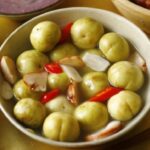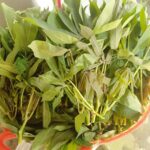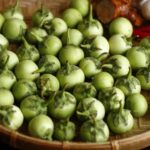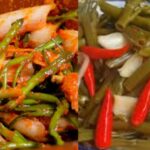Green, round and plump, dracontomelon fruits, more commonly known as sour fruits, are a popular summer treat in Vietnam. Beyond their refreshing qualities, these fruits can be transformed into a delicious traditional beverage: pickled sour fruit. This tangy, crunchy drink evokes childhood memories for many. However, achieving the perfect pickle—one that remains clear and flavorful without floating scum even when stored for extended periods—requires precise knowledge of the process. This article will reveal the secrets to creating delicious, crisp sour fruit pickles that can be enjoyed all year round, combining traditional wisdom with modern tips.
1. Understanding Why Pickled Sour Fruits Often Develop Scum and Slime
Before diving into the correct pickling method, it’s essential to understand why many pickled sour fruit concoctions end up with unsightly white scum or floating bubbles and develop an unpleasant odor after a few weeks:
- Contaminated utensils with oil residue or bacteria.
- Insufficient blanching of sour fruits, leaving residual sap or microorganisms on the skin.
- Undissolved sugar creates an environment conducive to yeast and mold growth.
- Using unboiled or tap water for pickling.
- Floating sour fruits during the initial pickling stage, leading to scum formation.
Improper sugar-to-water ratio results in an insufficiently acidic environment to inhibit bacterial growth.
By understanding these causes, we can formulate a precise recipe and procedure to prevent scum formation and create long-lasting, delicious pickles.
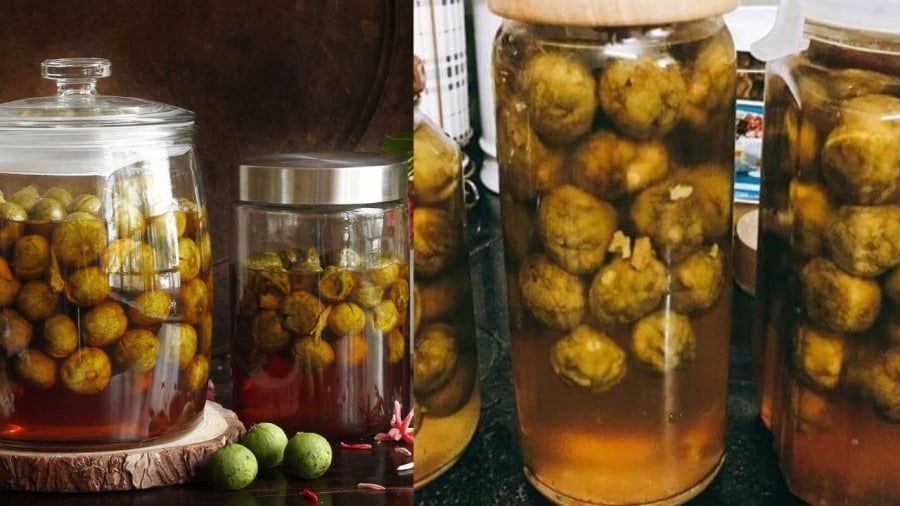
2. Essential Ingredients for the Perfect Pickled Sour Fruits
To create the ultimate crunchy and tasty sour fruit pickle, carefully select the following ingredients:
Fresh sour fruits: 2kg (opt for ripe sour fruits with slightly rough skin, intact, with stems)
White granulated sugar: 1.2kg (for a milder taste, consider using rock sugar)
Salt: 2 large spoonfuls
Ginger: 1 root
Boiled and cooled filtered water: approximately 1 liter
Clean glass jars with tight-fitting lids
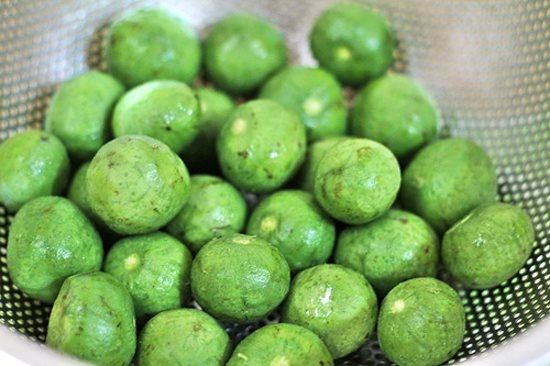
3. The Art of Pickling Sour Fruits: Crisp and Scum-Free
Step 1: Prepare the Sour Fruits
Peel the sour fruits: Use a small, sharp knife to carefully remove the green skin without bruising the flesh.
Salt soak: After peeling, soak the sour fruits in a brine solution (made with the salt) for 20 minutes to remove sap and eliminate any microorganisms.
Blanch the sour fruits: Boil water and blanch the sour fruits for 30 seconds to 1 minute, until the skin turns slightly yellow. Immediately plunge them into ice-cold water. This step ensures the sour fruits retain their crunch even after prolonged storage.
Step 2: Prepare the Pickling Liquid
Ideal pickling liquid ratio: 1 liter of filtered water + 1.2kg of sugar + 1 ginger root
Bring the mixture to a boil, stirring to dissolve the sugar completely. Add the ginger, crushed or sliced, then allow it to cool down before using. Boiling the liquid helps sterilize and dissolve the sugar, while ginger adds a subtle spicy note to the pickle.
Note: Using water that hasn’t fully cooled can cause the sour fruits to soften and promote scum formation.
Step 3: Assemble the Pickles
Sterilize the glass jars by rinsing them with boiling water. Ensure they are completely dry before use.
Arrange the sour fruits in the jars, adding a few slices of fresh ginger if desired for extra fragrance. Pour the cooled pickling liquid over the sour fruits, ensuring they are completely submerged. During the initial pickling stage, regularly shake the jar or use a clean spoon to keep the sour fruits submerged. If you have a weight that fits inside the jar, use it to keep the sour fruits immersed, as floating fruits can cause scum.
4. Storage Tips for Crisp, Scum-Free Sour Fruits All Year Round
Store the jars in a cool, dry, and well-ventilated area, away from direct sunlight.
The pickles will be ready to enjoy after 5–7 days, but they improve with age.
When removing sour fruits from the jar, always use a dry, clean spoon, avoiding any contact with wet utensils or hands.
If you notice a slight froth, it’s likely due to natural fermentation and can be skimmed off. However, if the pickles develop an unpleasant odor, become slimy, or the liquid turns cloudy, discard them.
5. Enhancing Your Pickled Sour Fruits: Tips and Tricks
Add a few slices of ginger or cinnamon sticks to your pickles for enhanced fragrance, flavor, and mild antibacterial properties.
For a clearer liquid and a more delicate sweetness, consider using rock sugar instead of white granulated sugar.
Pickled sour fruit drinks are incredibly refreshing on hot summer days, especially when mixed with lemonade and served over ice.
Mastering the art of pickling sour fruits requires attention to detail, meticulous hygiene, and traditional know-how. By following the precise steps outlined above, you’ll be able to create crunchy, scum-free sour fruit pickles that retain their freshness and flavor for an entire year. This traditional Vietnamese beverage is not just a refreshing treat but also a nostalgic reminder of simpler times and a cultural legacy worth preserving.
“Two Delicious Ways to Cook Tough Water Spinach Stems: A Tasty Treat for the Family”
Introducing the versatile and often underrated water spinach, a staple in Asian cuisine. Most of the time, we discard the older, tougher stems, opting for the tender young shoots. But with these two simple preparation methods, you can transform those forgotten stems into a delicious and nutritious treat. Uncover the hidden potential of this humble vegetable and elevate your culinary creations.

